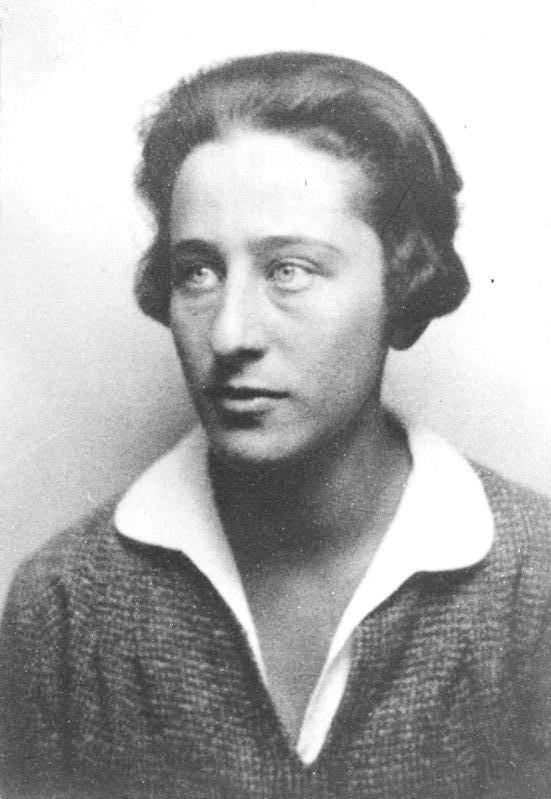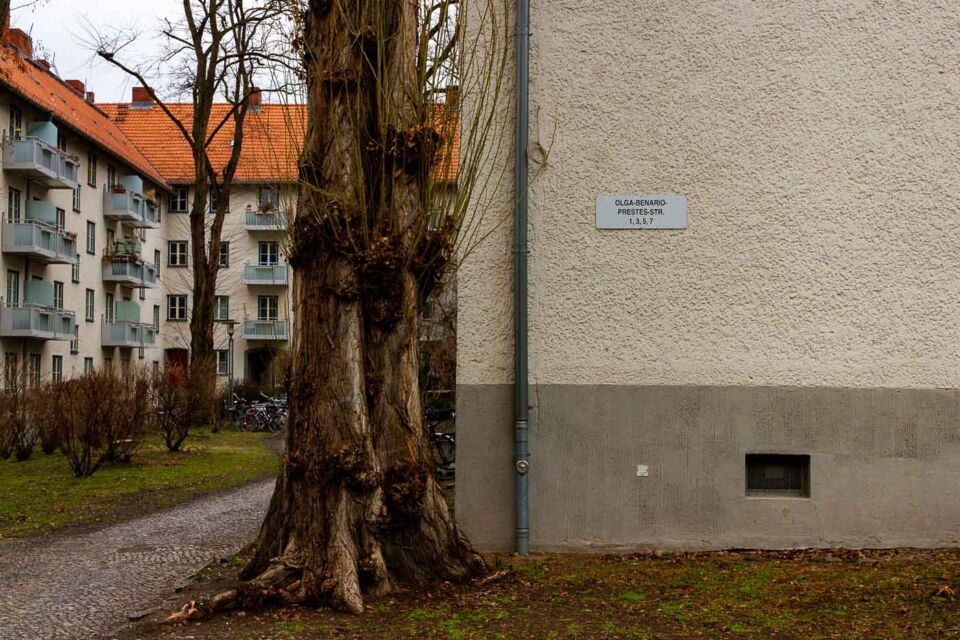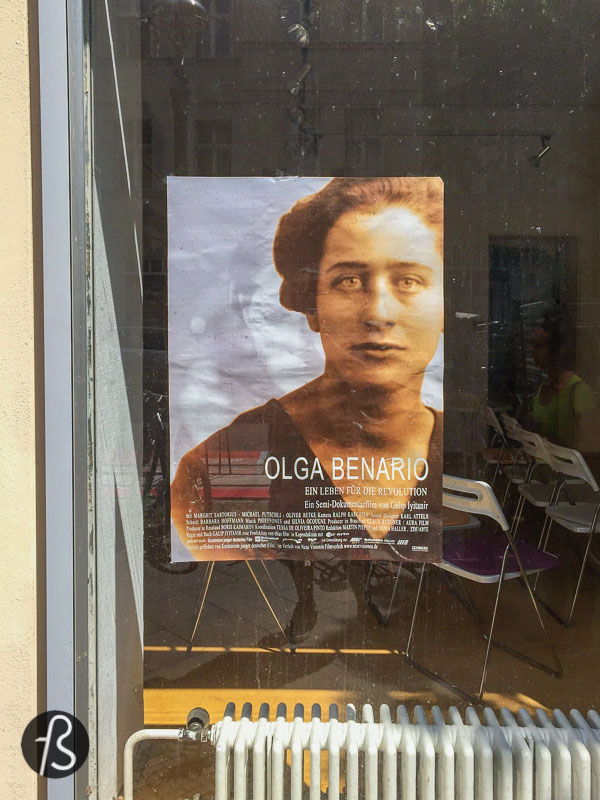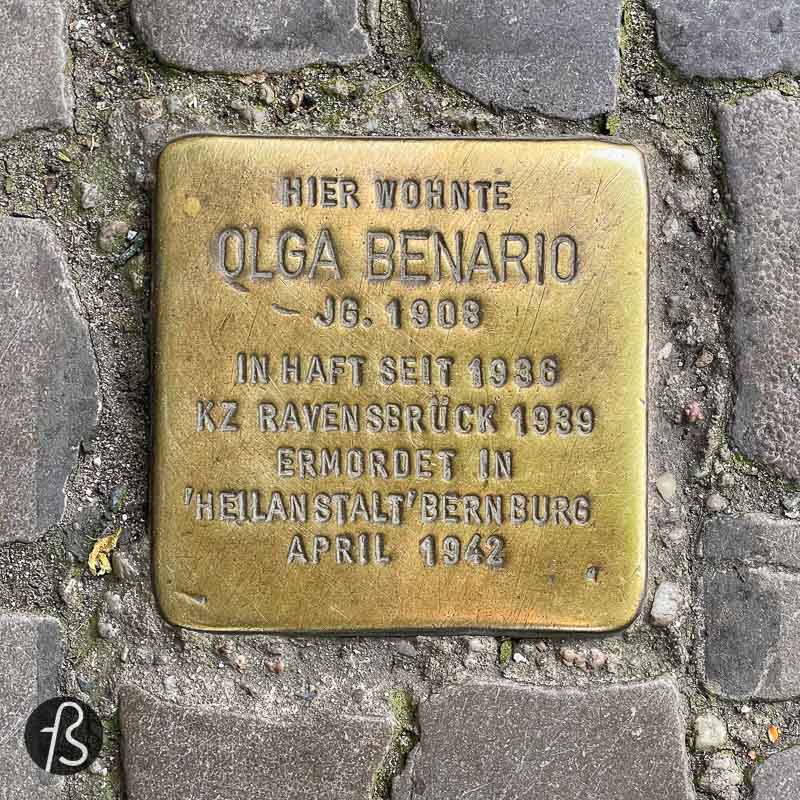Even though she was born in Bavaria, Olga Benário’s legacy lives in Berlin. The signs are spread around town, and we decided to write something about this German-Brazilian antifascist militant that was executed by Nazi Germany after being extradited from Brazil.
Growing up in Brazil, we learn about Olga Benário Prestes in history classes. We know about her time in the country, her deportation, and her relationship with Luís Carlos Prestes (a Brazilian revolutionary who was the general secretary of the Brazilian Communist Party for 40 years). But, at least for me, I don’t remember much about her history before all this.
Maybe it’s because I never paid that much attention to Brazilian history. Maybe, it’s because Olga Benário’s name sounds Latin to me, but it took me as a surprise when I learned that Olga Benário Prestes was born to a Jewish family in Munich.
After researching more and more about her life and exploring some of the places in Berlin that carry her name, I thought it was time to share what I discovered with those interested in her story of resistance and bravery in Berlin, Brazil, Germany, and beyond…
A little bit of the history of Olga Benário
Born in 1908 as Olga Gutmann Benário to a Jewish family in Munich, she joined the Communist Youth International, Kommunistische Jugendverband Deutschlands in German and known as KJVD, by the time she was 15. This happened in 1923, the same year that Adolf Hitler tried and failed to overthrow the Weimar Republic Government with the Beer Hall Putsch.
In 1926, she left Munich to work for the Communist Party in Berlin, where she became a leading KJVD functionary in the working-class neighborhood of Neukölln. During this time, she got into a relationship with Otto Braun, a professor and an experienced militant communist.
While in Neukölln, Olga Benário became the center point of the local communist youth, and her bravery made it to the Berlin newspapers in April 1928 when she led an armed raid to free Otto Braun. He was being accused of high treason. She managed to free him from a courtroom in the Moabit prison, and she became a well-known figure across the city.
There were posters with Olga Benário’s face all over town, and her face was shown before movies with offers of 10,000 marks to whoever had information that could lead to her arrest. Many people in the communist party and youth group opened their doors to her, and she managed to escape the police and Germany.
Olga Benário first escaped to Czechoslovakia, and, from there, she and Otto Braun found their way into the Soviet Union with false passports. Their relationship lasts until 1931.
During her time in Moscow, Olga Benário attends the Lenin School of the Comintern. Later, she works as an instructor at Communist Youth International. And gets elected a member of the presidium of the Communist International Youth. She also receives training in foreign languages as a pilot and parachutist.
In the summer of 1934, her life was about to change since, due to her military training, she was chosen with the task of accompanying Brazilian communist leader Luis Carlos Prestes back to his country. He was exiled to Moscow after leading the 1924 lieutenant revolt and his subsequent work with the Brazilian Communist movement.
Olga Benário was assigned as his bodyguard amid preparations to overthrow the Brazilian president Getúlio Vargas, who was changing his political instances into a dictatorship.
Olga Benário and Luís Carlos Prestes were disguised as a Portuguese couple going on a honeymoon trip to Brazil. They took a ship to New York and flew from Miami to Brazil. During this trip, the supposedly married couple fell in love.
In November 1935, the revolution against Getúlio Vargas failed, and the couple went into hiding. They escaped a police raid in Ipanema, and by January 1936, they were arrested in an anti-communist campaign declared after martial law was put into place in Brazil.

By Bundesarchiv, Bild 183-P0220-303 / CC-BY-SA 3.0, CC BY-SA 3.0 de, Link
In prison, separated from Luís Carlos Prestes, Olga Benário discovers that she is pregnant, and she uses an alias to hide from authorities. Her lawyers tried to avoid deportation and win some time until she could give birth in Brazil since the law forbids the extradition of nationals. Eventually, Brazilian diplomats found her real identity and were working side by side with the Gestapo.
In the end, the Brazilian Supreme Court declared that Olga Benário could be deported as a seven-month pregnant woman. Some even consider that this was done as a gift to Hitler.
In October 1936, she arrived in Hamburg, and she was taken to the Gestapo headquarters in Berlin-Moabit. In November, Anita Leocádia Benário Prestes was born in the Barnimstrasse women’s prison, where Rosa Luxemburg was before her. They were together for little more than one year until she was released into the care of her paternal grandmother, Leocádia Prestes.
In February 1938, she was first sent to the Lichtenburg concentration camp and, later, to Ravensbrück, a camp especially built for women. There, she was whipped, tortured, and placed in a punishment bunker while working as slave labor in a Siemens factory.
But those things didn’t break her. Olga Benário was named Blockalteste, or block elder.
She helped with a clandestine newspaper, made a small atlas, and used it to teach other prisoners about war and the world.
In February 1942, Olga Benário was taken to the Bernburg euthanasia clinic, and two months later, she was gassed to death alongside hundreds of other female political prisoners.
On April 23, 1942, she was killed in a psychiatric clinic that the Nazis had specially converted for mass extermination.

Anita Leocádia Benário Prestes was reunited with her father in 1945. She studied chemistry at university, was exiled to the USSR during the Military Dictatorship in Brazil, and is now a retired Professor of Brazilian History.

Three Places to Remember Olga’s Story of Resistance and Bravery
After the Second World War in Germany, Olga Benário was considered by many a heroine in her antifascist resistance and presented as the model of the female revolutionary. East Germany named schools and factories, and there is even a street in Pankow named after her.
Olga-Benario-Prestes-Straße is located across the street from Ernst-Thälmann-Denkmal. Until 1974, it used to be called Neukuhrer Straße, after a fishing village in East Prussian, where is Kaliningrad now. In September 1974, the street was named after Olga Benário.
In West Germany, she was ignored because of her status as a communist heroine. But her legacy is reaching more and more people. The rise in far-right movements made more people interested in her, and there is even a gallery with her name in Neukölln.



Olga Benário Gallery was founded by the Association of Victims of Nazi Persecution and the Association of Anti-Fascists, and they had their first exhibition in February 1984.
The gallery was named after Olga Benário for three reasons. They wanted to honor an antifascist woman, and she had to have a connection with Neukölln and be an internationalist. Olga fits all the criteria.
The gallery has exhibitions focused on informing visitors on subjects of current and historical interests that include migration and asylum, anti-racism, the women’s movement, union politics, and so on.
Next to the Olga Benário Gallery, you can find a stumbling block for Olga Benário.
A stumbling block, stolperstein in German, is a small brass plaque found all around Germany. Most of them are memorial stones for former Jewish neighbors, but there are also some for those involved in political resistance against the Nazi regime.
In December 2007, the Olga Benário Gallery donated a stumbling block and laid it for Olga Benário in front of the house she lived in in 1926. This is the house where Otto Braun and Olga Benário were arrested in their shared apartment.
This is the house at Innstrasse 24 in Berlin-Neukölln.

